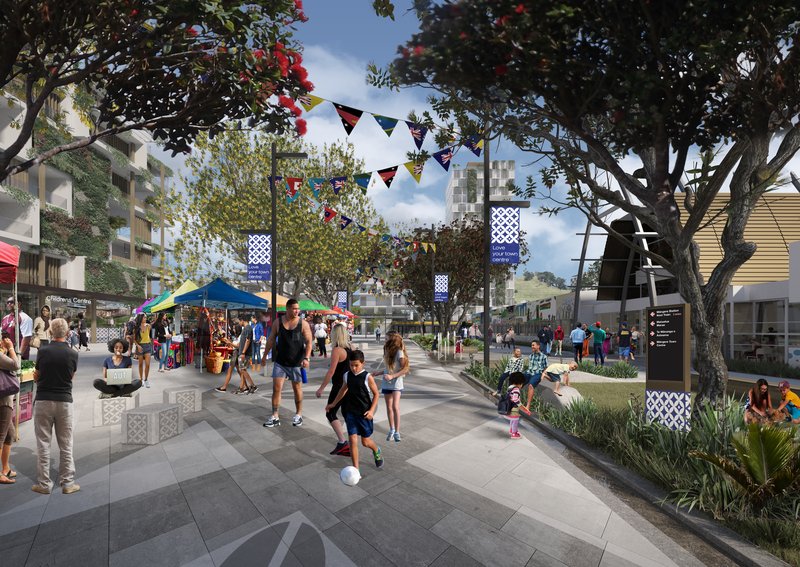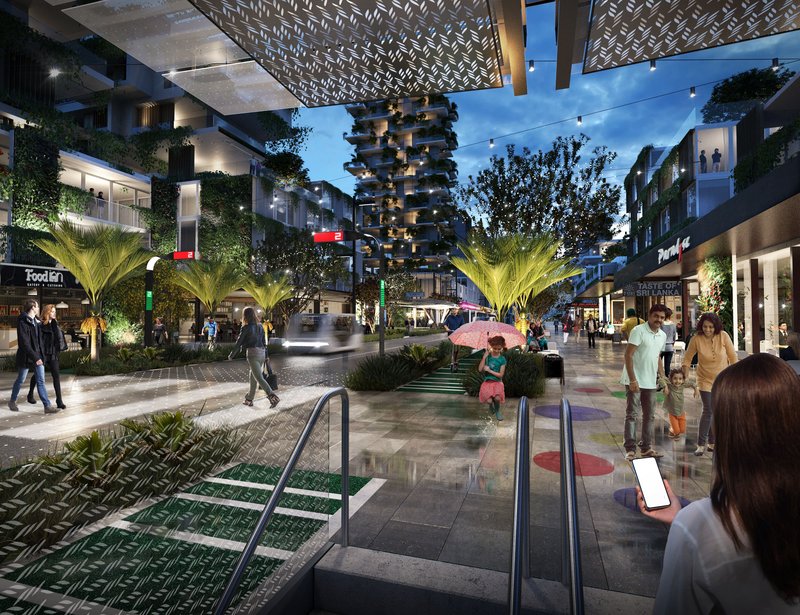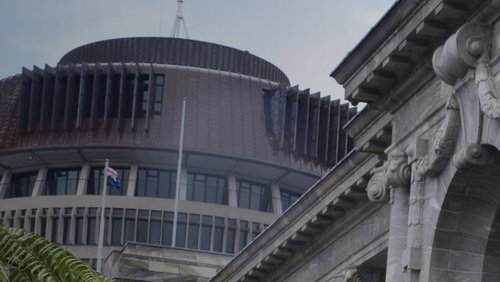13 Jun 2022
The recently unveiled light rail plan for Auckland is a public infrastructure project on a scale never before seen in this country. But what do engineers and transport and infrastructure experts think of the plan – does it go far enough? And what will it mean for engineers?
Our chronically congested largest city, Auckland, is to be retrofitted with a rapid transit network that, it’s hoped, will take thousands of cars off the road, catalyse new housing close to stations, create tens of thousands of jobs, and allow the city to grow sustainably into the latter decades of this century. In January, the Government announced a tunnelled light rail option, costed at $14.6 billion, that will run for 24km from the city centre to Māngere and on to the airport, with the section from the Wynyard Quarter to Mt Roskill fully undergrounded. Capable of carrying 15,000 passengers at peak (four times more passengers than a dedicated busway or trackless trams) the Auckland Light Rail (ALR) will integrate with existing train and bus hubs as well as the City Rail Link stations. The Government has also signalled it wants to accelerate a new harbour crossing by a decade, and potentially extend light rail to the North Shore and North West.

Auckland light rail, artist's impression. Image: Auckland Light Rail
A “city-shaping” project
Tommy Parker is Project Director of Auckland Light Rail, the entity responsible for developing the business case for the project, as well as engaging with stakeholders and partnering with mana whenua. Members include representatives of Waka Kotahi NZ Transport Agency, Auckland Transport, Auckland Council, the Ministry of Transport and Kāinga Ora. He describes what’s proposed as less a transport solution, more a “city-shaping” project that represents a fundamental break with Auckland’s historical pattern of sprawling development.
As for challenges, where do you start? The sheer scale of the project presents a major capacity and capability challenge, he says, not least in terms of attracting engineering smarts from here and overseas.
“We’re going to need geotechnical expertise and rail engineers, but there’s also that broader infrastructure provision, the city-shaping component, which is huge and will draw on most engineering disciplines,” he says.
“Yes, there are shortfalls of engineering talent across the globe, but I’m optimistic we can mitigate that risk. It’s about being well planned and utilising the attractiveness of this opportunity. Auckland is a great city for people to come and work in, and this project has all the engineering challenges. If you can’t get excited about it, then you don’t have a pulse.”
He adds: “Other challenges include the issue of carbon reduction. This will play a big part in decarbonising the Auckland transport network, but there’s the issue of embedded carbon during construction. We’re going to have to innovate and stretch ourselves to do the best we can there. We’ve also got to raise the bar in terms of our partnership with mana whenua and the ownership they have and feel for this project. Finally, the social licence for this has to be very broad and genuine, and that’s about being inclusive with the community, the businesses that will be affected, residents and stakeholders.”
Engaging with Māori
In terms of engaging with Māori, that process began with the ALR Chair Leigh Auton meeting with the chairs of 13 of 15 iwi mana whenua of Tāmaki Makaurau – a rangatira to rangatira approach. Running alongside those discussions, there was targeted engagement with mātāwaka – Māori who don’t whakapapa to local iwi but have large populations in the areas where intensification will occur, such as Māngere. Those initial hui resulted in a Māori Outcomes Strategy, or Te Rautaki Huanga Māori, which sets the framework for ongoing partnership.
A consultant supporting mana whenua engagement on the ALR project, Eynon Delamere, says three main themes emerged from the initial engagement with iwi: the significance of the Manukau Harbour and the need to protect its wellbeing; the importance of the environment and protecting taonga and wāhi tapu; and ways in which the project could potentially be a catalyst for growing the Māori economy.
Engagement will increase as we get into more detailed planning; we will be trying to embed Māori values into the fabric of the project. – Eynon Delamere
“We’re looking at engaging with Māori at all levels of the project. There’s going to be a Sponsors Board with mana whenua representation alongside Cabinet ministers and the Mayor. Mana whenua will be involved in decision making all the way through,” says Eynon, who believes the Māori perspective will be particularly influential when it comes to sustainability outcomes and the environment.
“Engagement will increase as we get into more detailed planning; we will be trying to embed Māori values into the fabric of the project.”

Māngere Town Centre, artist's impression. Image: Auckland Light Rail
Experts respond
But what do engineers, and transport and infrastructure experts think of this transport plan?
Bridget Doran CMEngNZ CPEng, Chair of Engineering New Zealand’s Transportation Group, starts by noting that investment in public transport is crucial in growing coastal cities such as Auckland.
“Many Transportation Group members would applaud this project because it’s such a significant statement about the value of public transport,” she comments.
“However, our members may also caution that investment of such significant amounts of money should be very carefully weighed up against other, less-expensive options to help everyone access opportunities while fighting climate change and keeping the travelling public safe and healthy. It’s very complex, very political, and our members welcome informed debate.”
Prior to taking on her role as Group Leader for Arup’s New Zealand operations, Mayurie Gunatilaka led teams at Waka Kotahi NZ Transport Agency responsible for long-term strategic planning and the national spatial and urban development programmes for land transport. Mayurie emphasises the city-shaping vision at the heart of the ALR plan.
“This will shape not only the dimensions of the city and how we move, but how we live within it,” she says.
“It’s about giving people options for how they travel, adjusting the ‘shape’ of the city so that people can choose to live in places where it’s possible to travel easily to work and for leisure without needing to get in a car, and, most importantly, providing opportunities for people who live in areas not currently well served by transport infrastructure.”
She also stresses the sustainability payoff of the ALR. Currently, the transport sector accounts for 43.6 percent of Auckland’s emissions, and the vast bulk of that is from road travel, she notes.
“Getting more people out of cars and on public transport is critical to help meet our climate goals.”

Sandringham, artist's impression. Image: Auckland Light Rail
Inspiration from outside
Auckland-based railway engineering consultant Michael Than CMEngNZ has questions about the detail of the ALR plan, but he likes its scope and ambition. A member of the Railway Technical Society of Australasia with 20-plus years of experience in the global rail infrastructure business, he argues light rail at scale is “almost a no-brainer” for Auckland.
“This is going to hurt now, but in 15 years the city will be so much better for it. It will allow us to grow.” He says Auckland is ready for this. “Look at the intensity of bus traffic to the North Shore. You can deliver much more capacity with tram or light rail. On the engineering side, there are tonnes of studies showing that those modes are much more energy-efficient than buses.”
Michael has been involved in rail projects in Australasia, Europe and the Middle East. He was a Paris-based technical manager for French rolling stock manufacturer Alstom (its stable includes the TGV and Eurostar) for several years, and recently operated as technical reviewer for Alstom on its light rail solution for the coastal Qatar city of Lusail, which includes a mix of underground and surface sections.
There are plenty of overseas examples that ALR could look to for insight, he suggests. “Copenhagen, for example, which I was a rail engineer on in 1999. There it’s light metro, but it was built in a densely populated area, and there are lessons in that project that could be applied to Auckland.”
Lusail is a different situation, being a new, planned city, but there are technical lessons that could be drawn from that project. “One is power supply. They used a very sophisticated system with power embedded in the ground, requiring less clearance and smaller tunnels. It’s used in Sydney, too, and is very clean, with no overhead wires.”
He stresses that knowledge building is going to be a critical aspect of the ALR, particularly given New Zealand’s dearth of experience in major rail projects. “It’s not just a question of procuring a system (from an overseas contractor),” he says, adding that the system needs to be maintained and operated once it’s built. “That knowledge transfer is a very important part of building a transport system.”
Likewise, innovative New Zealand-specific solutions will be key – a point underscored by the way the pandemic has totally disrupted global supply chains. “Something that works perfectly in Lusail or Copenhagen might not work here. We can take inspiration from outside, but we need to adapt that to local needs. And engineers will be critical to that.”
He predicts the project will be a boon for engineers. “There will be opportunities in every aspect of engineering – mechanical, civil, structural, electrical, computer science,” Michael says. “I’d urge New Zealand engineers to have patience and please don’t head off overseas.”

Workers on the light rail project in Lusail, Qatar. Image: Michael Than







